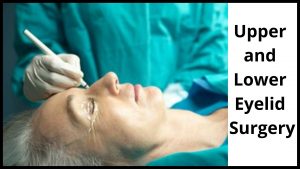
What to Expect with Upper and Lower Eyelid Surgery is quite important for any plastic surgeon.
Droopy upper eyelids and small bags under the eyes can be quite an embarrassment.
Aside from making you appear older, drooping eyelids can also lower a person’s (subconscious) side (vision) perception.
Blepharoplasty, the procedure itself, can help fix these problems and enable patients to look years younger within the procedure itself.
Another way in which this procedure can be beneficial is in the removal of fat under the eyelid area.
What many patients don’t know is that the majority of fat that is stored on their upper eyelid comes from fat pockets that are not really necessary.
Upper and Lower Eyelid Surgery – What to Expect.
These fat deposits are actually not as harmful as many people think they are.
In most cases, there are excess fat deposits under the skin that are simply leftover due to old age.
During the procedure, however, it is possible to remove these excess fatty areas.
This will most definitely improve the overall look of a patient s eye contour.
There is one particular concern that many patients have regarding upper or lower eyelid surgery.
This concern is actually more common than many realize.
Many patients do not go in for the procedure because they have a fear of what will happen after the fact.
Although some people do undergo revisional surgery, this type of treatment does not really restore lost vision.
What this means is that you need to go in for a consultation with a board-certified surgeon who specializes in this type of vision correction.
People who are considered ideal candidates for the procedure must meet a few basic criteria.
Individuals who are extremely honest and who maintain good overall health are going to be good candidates.
Ideally, candidates who have not had any major accidents that would preclude the procedure should also be able to come in for the consultation.
In addition, individuals who have extremely healthy eyes will fare better during the recovery period and will also be better candidates for the procedure.
Upper and lower eyelid surgery can either be performed by an expert or in an “off-the-shelf” fashion.
The first type of procedure is called an incision.
This method for making an incision involves the use of a tiny incision which only requires a clean cut.
The excess fat and skin are then removed via this small incision.
This method is ideal for individuals who want to remove excess skin but who do not want to see any scars on the upper or lower lash line.
Bleeding and swelling will be another issue that will be encountered during the recovery period.
In some cases, your physician may recommend the use of topical eye drops, which can help reduce the amount of swelling you experience.
There will also be minor bruising which should lessen over time.
Generally, however, bruising is uncommon with upper and lower eyelid surgery.
It should be noted that Blepharoplastic surgery has the possibility to cause additional side effects and complications.
For instance, excess bleeding, swelling, and redness could occur with any eye surgery.
Sometimes, additional surgeries may be required to correct these issues.
Other complications that can occur with blepharoplasty surgery are excessive facial swelling and tenderness.
It is important to realize that if you choose to pursue this surgery, you should be prepared for additional surgeries and for possible infection.
Proper pre-and post-operative care and use of anesthesia will help you avoid unnecessary complications.
If you have undergone upper or lower eyelid blepharoplasty, it is important to maintain appropriate expectations regarding your final appearance.
Your appearance will most likely not change dramatically following the procedure, although your eyelids may change their shape and movement for the first several months following the surgery.
Most patients appreciate improved vision and increased eyelid visibility.
Many also report having less neck or head pain associated with their surgical procedure.
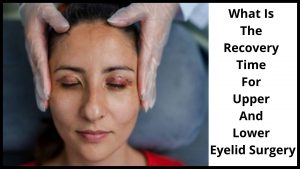
What Is The Recovery Time For Upper And Lower Eyelid Surgery?
Recovery time for upper and lower eyelid surgery depends upon your surgeon, the type of procedure you have, and your age.
Eyelid surgery typically requires a recovery time of two to three weeks.
This will depend on many factors.
The length of time that your face remains closed and the amount of swelling present will influence this time frame.
A small incision will be made above and/or below the eye, and excess or loss of the tissue will be surgically removed.
Some loose skin may be trimmed off; the surgeon will advise you of any remaining excess tissue that must be surgically removed.
One to two weeks is also typical for the healing of eyelids that have been cut during upper lid eyelid surgery.
It will take a couple of weeks for your eyes to become accustomed to their new position and for them to appear wide open.
Your upper eyelids will become dark when they do heal, so you should make use of contact lenses or dark glasses as appropriate.
If you have had your upper lids eyelid surgery performed during the winter season, then you should wait until they have warmed up prior to using any makeup.
Recovery time for surgical wounds is three to four weeks, and this can be extended by one week if it is done under general anesthesia.
It is extremely rare that a patient has to stay in the hospital for more than a week after having an upper lid eyelid surgery procedure.
Small wounds rarely require suturing.
Any small or moderate surgical wounds will heal in a matter of days.
Minor surgical wounds do not need to be sealed by sutures but should be allowed to air out for a few days.
After your surgeon removes the excess fat from your upper and lower eyelids, he will make a small incision in your upper lid.
Then he will remove a section of the lower lid above this incision.
This is called the levator muscle.
An eyelid muscle that has been strained or is otherwise injured cannot heal properly.
The muscle tissue is completely sealed off and cannot heal as it would in a normal situation.
And the incisions made during an upper lid eyelid surgery are relatively small since the surgeon does not have to make as many incisions.
Thus the wound does not need to be as large.
The incisions made are also of a smaller diameter, as the surgeon has fewer chances to get a cut that is too large.
The surgeon then places stitches in each of the incisions that he made during the procedure.
He can sometimes use sutures.
In most cases, however, a plastic surgeon prefers to use gauze strips.
These steps will help to reduce the amount of swelling that occurs in the area of the eyes.
Once the surgery has been done and the muscles have been sealed off, the eyelid surgery will then be covered with a bandage that will be left on for a period of at least one week.
The bandage will prevent any bleeding that might occur.
This will help to speed up the healing process.
However, it is possible for the healing time to vary, depending on your individual case.
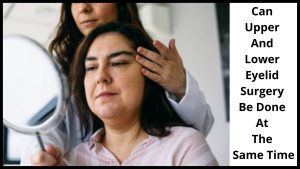
Can Upper And Lower Eyelid Surgery Be Done At The Same Time?
There are several people who wonder whether both upper and lower eyelid surgery can be done at the same time.
This is a common question because when you have two different procedures that are trying to achieve the same result, you end up with a double job.
However, when it comes to the matter of upper and lower eyelid surgery, it is possible for both of these procedures to be done at the same time.
Of course, you will need to find an expert surgeon in order to make this happen.
The first part of this procedure deals with putting the upper and lower halves of your eyelids together.
This is accomplished by making incisions on both sides underneath your upper and lower eyelashes and inside of your creases.
In order to get an accurate idea of just how much skin you will end up losing, it would be best to have a plastic surgeon estimate the exact amount that you will end up losing.
The amount of fat and skin that is removed during this portion of the procedure is quite substantial.
However, this is not always visible during the initial consultation.
The second part of the upper and lower eyelid surgery involves repositioning the muscles around your eyes.
Once you have got the incisions inside of your creases made, then the surgeon will look into repositioning the muscles on either side of your upper eyelid so that they will look naturally out to the side instead of being positioned directly above your eyes.
Of course, you will need a very skilled plastic surgeon to be able to accomplish this successfully.
Any type of procedure that requires a great deal of skill and experience will almost always require a visit to a surgeon that specializes in that particular area.
If you are thinking about upper or lower eyelid surgery, the size of your upper eyelids will also need to be determined.
This part of the surgery involves cutting away some of your lower eyelids to get to your upper ones, then suturing the incisions closed.
Any loose skin or tissue will need to be surgically removed.
After the operation, any excess skin or tissue that was not removed will have to be surgically repositioned in order to create the illusion of a larger area of space where your eyes once were.
Many patients are eager to get rid of the bags under their eyes.
However, this problem can sometimes be more complicated than one would have imagined.
Many potential solutions exist.
And many of these include physical therapy, ointments, and creams, laser surgery, or natural solutions.
If you suffer from wrinkles around your eyes, then perhaps an upper or lower eyelid reduction is your best solution.
But before you decide to go under the knife, it is important to determine whether or not the surgery will provide you with long-term results.
Sometimes the most dramatic changes can occur by using both upper and lower eyelid plastic surgery.
In fact, many plastic surgeons today are doing this type of treatment on a regular basis.
If you want the most dramatic change, and if you don’t mind spending a bit more money, then this option may be right for you.
Just remember, however, that the plastic surgeons who do this work are often well known in their field, and may have much better credentials than “do it yourself” doctors.
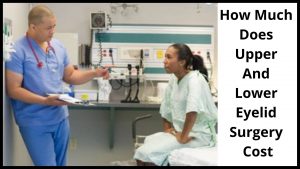
How Much Does Upper And Lower Eyelid Surgery Cost?
For patients who are paying out of pocket for their eyelid operation, understanding upper and lower eyelid surgery cost implication is essential in ensuring you get the most appropriate treatment for your budget.
While some surgeons will quote a fixed price on an upper or lower eyelid surgery for a particular area, you may find that your surgeon is offering a more competitive price on an upper or lower eyelid surgery but you are getting a different kind of surgical procedure in return.
Usually in the United States, it cost between $5,000 to $7,000 for lower blepharoplasty. While it is about $4,500 to $6,500 for upper blepharoplasty.
So, for both surgery, it will come to the range of about $7,500 to $10,500.
If your surgeon is not advertising their prices in public, it’s important to question them directly.
Find out if the cost they are quoting you for the upper or lower eyelid surgery is the flat rate they offer to all patients.
Or is it a more competitive price depending on whether you are a new patient or a repeat customer?
If it is a competitive price then chances are good that it reflects a market where the surgeon has a strong reputation for bringing the best treatments to patients at a price that is affordable.
It is not uncommon for a surgeon to say that upper or lower eyelid surgery is their most competitive procedure.
This is because each patient is different, and what works for one person may not work for another.
Your surgeon should be able to explain the procedure fully to you in detail to help you understand the complexities.
The more complex the procedure, the more factors that go into determining the overall costs.
For example, the size of the eye, the distance between the base of the lower eyelid and the upper eyelid, the skin thickness, the amount of fat removed from the upper and lower eyelids, and the patient’s natural eyelash characteristics are all factors that will all need to be taken into consideration.
It may take more than one surgery to achieve the final result.
Therefore, the initial estimate for upper and lower eyelid surgery may not reflect the final bill.
It is important that you get an itemized list of costs so you know exactly how much the procedure will cost overall.
In addition, if you have a history of eye diseases such as glaucoma or cataracts, your surgeon may recommend that you avoid any type of laser eye surgery.
They can examine your eyes and check for signs of these diseases before starting your treatment.
This is why you need to be completely honest with your surgeon about having had any eye disease in the past.
Some people who have had plastic surgery on the upper eyelids have experienced excessive swelling or redness.
This can cause the eyes to look artificial after the surgery.
The final cost of upper and lower eyelid lift will be determined by which approach your surgeon takes when performing the operation.
He or she will determine how much skin needs to be removed, how much fat has to be removed, how much under-eye bag has to be removed, and how much forehead lift has to be performed.
All of these things will contribute to the final cost of the treatment.
Therefore, it is important to discuss everything possible with your surgeon before the surgery.
Your doctor will discuss the best course of treatment and which options will be most beneficial to you.
In general, the upper and lower eyelid lift is considered minor in comparison to other procedures such as the botox procedure, which can be more expensive.
It is important that you do not feel bad if you have to pay more money for this procedure because in general, the results are better.
However, if you are suffering from severe under-eye bags, crow’s feet, excessive dark circles, excessive puffiness, excessive sweating, and fatigue or sleeping problems, then this may be the best option for you.
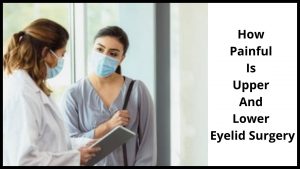
How Painful Is Upper And Lower Eyelid Surgery?
This is one of the most common cosmetic plastic surgery procedures performed, and yet most people don’t know the answers to this question.
Eyelid surgery involves the removal of excess skin, fat, and sometimes muscle from the upper and lower eyelid areas.
This surgery is also commonly done to remove excess fat around the eyes.
The muscles that help you open and close your eyes are called the levator muscles.
The exact location of these muscles is in the area of the iris (the colored part of your eye).
Excess tissue in these areas can make your eyes look larger or smaller than it really is.
Eyelid surgery will result in either a tighter or smaller lid.
Sometimes there is just a minor pain or swelling at the site of the operation.
Other times there is considerable pain, and the surgery is often accompanied by general anesthesia.
The pain is usually most severe in the morning and during the night but can be reduced with an eye patch.
Some people may have pain only near their eyes or sometimes in their eyes.
And some people will have both sides of the lid affected by the excess tissue removed.
The area around the eye is very sensitive, so some patients may have difficulty sleeping at night.
While talking to your eye doctor about how painful is upper and lower eyelid surgery, ask him about possible complications such as infections, scarring, or loss of vision.
The surgery can be very effective for reshaping the eye.
It helps to eliminate the extra tissue and tightens the muscles beneath the eyelid.
However, it is important to note that this is not the same thing as eyelid muscle retraction, which is often used in weight-loss surgery.
Eyelid surgery is designed to lift and constrict the muscles to give a more youthful appearance and improved eyelid movement.
How painful is the upper and lower eyelid is often related to the surgeon’s skill and experience?
It is important to select a highly skilled professional who uses the best equipment and techniques.
If you have an excessive amount of loose tissue and/or skin, you may experience pain.
Some patients find that putting makeup on causes additional pain, especially when doing eye shadow.

Is Blepharoplasty Worth The Money?
Many people wonder if blepharoplasty is worth the money.
Most of us have noticed how crow’s feet, the lines around our eyes, and bags under our eyes get worse as we age.
Many people also want to get rid of their wrinkles.
If you’re asking yourself this question, you may want to consider this plastic surgery option.
In general, yes, blepharoplasty is a procedure that is considered cosmetic.
Your eye doctor will decide whether this surgery is medically necessary based on your answers to a few questions.
Most of the time these questions are very similar to those that you might be asked when you visit a doctor for routine eye exams:
How many eyelids droop? Is your upper eyelid drooping? Do your lower eyelids look hollow?
These are all typical questions that people may be asked when they visit an optometrist.
Many people have spent a lot of time and money trying to make their eyes look better but the results often aren’t permanent.
One of the best solutions to this problem is to use eyelid surgery to remove unsightly bags from your eyes and to increase your cheek-lining.
Most people who undergo this surgery are surprised to see how much improvement in their appearance makes.
However, most people who have had this procedure are thrilled with the outcome.
Eyelid scar cream is often used after this operation to help the area look younger.
Blepharoplasty isn’t an overnight fix.
It’s typically performed during a recovery period of several weeks.
During this period, your eyes will be very sensitive and you won’t be able to sleep well.
Blepharoplasty is worth the money if you’re experiencing these symptoms because you will see dramatic improvements in your appearance in just a few weeks.
Your eyes won’t be droopy anymore and they will look fuller.
Blepharoplasty is another great solution for those who have droopy eyes caused by eyelid surgery.
If you undergo both upper eyelid surgery and lower eyelid surgery, then you can get a double lift.
This will increase your cheek-line and make your eyes look even larger.
Blepharoplasty is definitely worth the money if you’re unhappy with your eyes.
Botox is another option for those who need to improve their appearance.
Botox is injected directly into the muscles of the eyelid.
The Botox gets injected into the muscle fibers, which relaxes them.
It is possible to get rid of bags under the eyes and eliminate wrinkles around the eyes that you don’t like.
Blepharoplasty and Botox are definitely worth the money if you’re tired of using eye makeup and want your eyes to look clearer.
The most popular procedure is called crow’s feet and involves tightening and lifting the skin around the eyes.
The skin is lifted up and then the muscles are tightened, creating a wrinkle-free appearance.
And the downside of this procedure is that it can cause reddening around the eyes, temporary bruising, and swelling, and a little scarring.
Many people say that it looks best on people with lighter skin, but there are products out on the market that is designed to help people with darker skin tones look their best.
I think that both procedures are good solutions for people who are tired of trying different products that don’t work.
If you are thinking of getting one of these cosmetic procedures done, I suggest that you do some research before you make an appointment to come in for a consultation.
Not only will you find out more information on the risks and benefits, but you’ll also find out about some great skincare products that have been proven to reduce crow’s feet, wrinkles, and other signs of aging.
It is important that you consider all of your options before making any permanent decisions about your appearance.

Does Eyelid Surgery Make You Look Younger?
There is no doubt that you can indeed regain a better youthful appearance through this procedure.
However, you have to ask yourself whether this is really what you want.
After all, if you do not like the way that your face looks now, why would you spend money on eyelid surgery?
You may find that the answers to these questions are different from what you were led to believe before you considered eyelid surgery.
If you are looking for ways to look younger and would like to rid yourself of lines and wrinkles around your eyes, then you should take a long, hard look at this procedure.
As an example, did you realize that you can get rid of bags and dark circles under your eyes by having eyelid surgery?
Many women suffer from eye bags, but these problems do not make them look older.
Instead, they are simply caused by the lack of collagen beneath the skin.
Through the use of lasers, the muscles in the area can be rejuvenated and the eyes can once again be filled with life.
Did you know that this particular surgery can also help to improve the volume of your eyes?
If you need to wear glasses to help you see well, then this procedure might be exactly what you need.
There are some people who have extremely large eyes, and they are unable to wear glasses due to the fact that their faces are too large.
In order to look younger and more attractive, these people will often turn to cosmetic surgery so that they can eliminate the bags and dark circles underneath their eyes.
While this is certainly one of the benefits of this operation, you should understand that it can also help to improve the firmness of your cheeks and eyelids as well.
If you have ever been disappointed with the size of your lips, then this can certainly be a way to get your lips to look plumper.
And if you are worried about the effect that these procedures can have on your appearance, there is no need to worry.
Since this type of cosmetic surgery is routinely performed on adults and teenagers alike, there is very little difference between the results that you can expect.
The only thing that you can do to minimize any possible changes that you might see is to consult with your doctor.
This means that you should make an appointment to go over the details of your procedure so that you can decide if you are willing to go ahead with it.
He or she can explain to you everything that you need to know, including the risks that can occur and how long the procedure may take.
Eyelid surgery can certainly have beneficial effects, but you will need to consider all of your options carefully before going ahead.
You can always choose to try out other cosmetic procedures, which can make you look younger for a longer period of time.
There is no reason why you should not be able to get the surgery done without feeling as though you are being forced to alter your appearance because you are worried that it may change your appearance.
If this sounds like something that interests you, then you should learn more about eyelid surgery so that you can find out if it would be a good idea for you to pursue.
You should never rush into any kind of a major medical procedure, no matter how tempting it may sound.
And you should make sure that you consider all of the different ways that it can change your appearance and the benefits that you can reap from having it done.

Who Is A Good Candidate For Eyelid Surgery?
The simple answer is that anyone who is mildly overweight has droopy eyelids, or has an unusual appearance of skin folds.
The long version of this question is “What makes a good candidate for blepharoplasty?”
The simple answer is that you must be able to have an eyelid that can be reattached by means of an incision in which the surgeon has room to operate.
Properly formed and fitting eyelids are the preserve of the genetically inclined, while the less developed are left with this second option.
In the case of those who have excessive skin or fat deposits along with the iris, excess skin removal, or reduction will be necessary to restore proper shape and function.
This removal is also one of the most common reasons for which eyelid blepharoplasty is performed.
In fact, almost all patients with excess skin or fat are candidates for some sort of eyelid reduction.
Those with underdeveloped eyelids and/or drooping eyelids should also consider this treatment.
Who is a good candidate for eyelid regeneration after blepharoplasty?
The answer depends on what part of the face was affected by the original blepharoplasty procedure.
If the procedure was performed on the upper eyelid region, the area will typically be recreated by means of a sagging skin graft from the inner cheek.
In any case, this area will need to be repositioned, and thus another incision made into the eye socket.
Who is a good candidate for eyelid reduction after blepharoplasty?
If the patient is young, he/she probably has elasticity in the muscle behind both eyes.
In any case, the surgeon will have to perform a number of small-scale exercises to encourage this muscle to regrow and get back to its prior position.
Any candidate who lacks elasticity in this area should not consider this treatment.
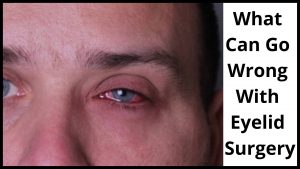
What Can Go Wrong With Eyelid Surgery?
What can go wrong with eyelid surgery? It depends on your doctor and on the procedure that you have.
Eyelid plastic surgery has its risks, but the potential benefits should be enough to make you comfortable with the decision.
It’s important to understand that just because the doctor says it will be a minor operation doesn’t mean that it won’t have unforeseen complications.
The possible risks of removing part of the eyelid are very real and the potential benefits are great.
What can go wrong with eyelid surgery?
Most cosmetic procedures are safe, but there are rare complications that can occur.
The bleeding, infections, allergic reactions, scarring, pigment changes, unevenness, injury, and irregularities can occur with any eyelid surgery.
If you are not carefully monitored, these complications can increase instead of decrease.
Eyelid plastic surgery can lead to a small amount of bleeding, which usually occurs during the first week after the surgery.
You should let your doctor know if you experience any swelling or redness.
And within some days all these side effects will vanish.
If they do not go away, call for emergency surgery as soon as possible.
What can go wrong with the procedure?
This is an obvious one.
Although many surgeons try their utmost to prevent eye infections, there is always a chance that one can occur.
Your doctor will need to examine the tear ducts and the area around the eye to check for signs of infection.
He may also instruct you on ways to avoid eye infections, such as using special eye drops.
What can go wrong with the procedure?
One of the most common complaints of patients report is dry eyes after eyelid plastic surgery.
Sometimes this is temporary and can be treated with artificial tear lubricants.
More often, however, it becomes a problem that can require eye drops and possible antibiotic treatment.
The doctor may also recommend an alternative vision solution such as bifocals.
A more likely issue will occur during the recovery period following surgery.
Your surgeon may instruct you to avoid rubbing your eyes or look for an alternative solution to dry your eyes.
Also, you need to know that your eyes are very delicate.
Your eye skin is thin and is prone to swelling and leaking.
Sometimes it even peels off, from under the eye.
The delicate nature of this tissue means that any injury to this area can lead to a lot of problems, especially if the injury is major.
One major complication that can occur in the process of eyelid surgery is that the fat under the skin can become so thick that the skin under the eye will bulge out.
Is that there are no risks involved, then you might want to rethink your decision.
You see, there are risks involved, and they are not as minor as you might think.
Risks like the development of drooping eyelids, development of an asymmetrical appearance of the eyes, presence of scars, and excessive development of muscle at the surgical site are all risks that you need to keep in mind when you are thinking of getting eyelid surgery.
Removing the lower lashes can cause excessive swelling, eyelid bumps, and even scarring.
This should not be the case since this is the most common procedure that is performed on patients who have undergone the surgery.
The doctor will usually give you a list of possible complications that may occur with the removal of eyelashes and then let you decide whether or not you want to go ahead with the procedure.
A qualified ophthalmologist has many years of experience in performing surgery on the eye.
This means that they know what can go wrong with eyelid surgery.
In fact, some of the most common complications that people experience during the surgery itself can happen during the recovery period.
In addition, the amount of time it takes for your eyes to heal can affect the look and the results of your surgery.
If you are having a normal amount of surgery then you should be able to return to your normal routine within a few days of the surgery.
Make sure that you choose a board-certified plastic surgeon who is experienced and qualified to perform the procedure.
Eyelid plastic surgery is similar to any other type of surgery, so you should expect to receive instruction and supervision.
A doctor who is very careful with his patients is more likely to provide you with a quality service.
Don’t hesitate to ask for the medical history of your potential surgeon to ensure that you aren’t at risk for any complications.

Conclusion:
Upper and lower eyelid surgery can be performed under either general or local anesthesia depending on the circumstances.
There are several different types of upper and lower eyelid lifts that can achieve different effects.
For example, tucks can result in tightening, reducing the appearance of bags around the eyes, increased softness, and definition in the upper eyelids, and definition of the lower lids.
However, the most common outcome is that the upper eyelids become tighter and the corners of the eyes look less baggy.
This type of surgery may also correct drooping eyelids, hyper-pupillary reactions, and excess skin around the eyes.
While both upper and lower eyelid lifts have their advantages and disadvantages.
Your doctor should be able to advise you on which procedure would best meet your requirements, both from an aesthetic and from a cost point of view.
Whilst upper and lower eyelid surgery will be similar and involve the same basic components such as removal of excess skin and the re-sculpting of the bone and skin to produce a less prominent upper lid.
The two processes involved may differ slightly due to the location and depth of the incision.
The positioning of the scars, and whether the scars are located below the eyelashes, above the lashes, or between them.
A smaller incision for an upper lid can also cause some slight swelling and puffiness after the procedure has been completed, and this may also affect the final outcome.
There are also many differences between these two procedures based upon the visibility of the scars.
If they are visible, upper eyelid surgery is likely to be more effective, and more successful if done with the use of a high-strength filler.
